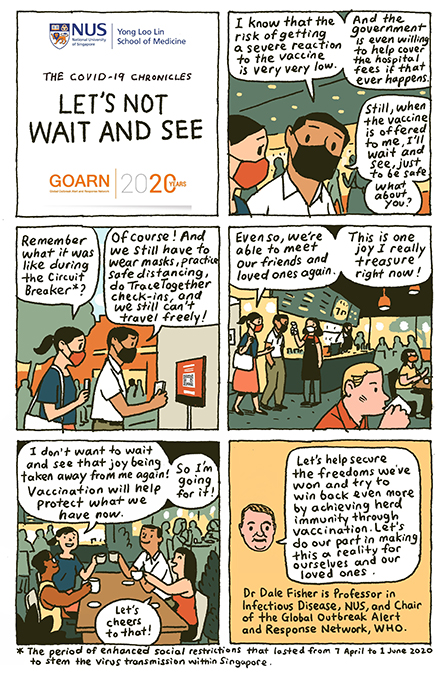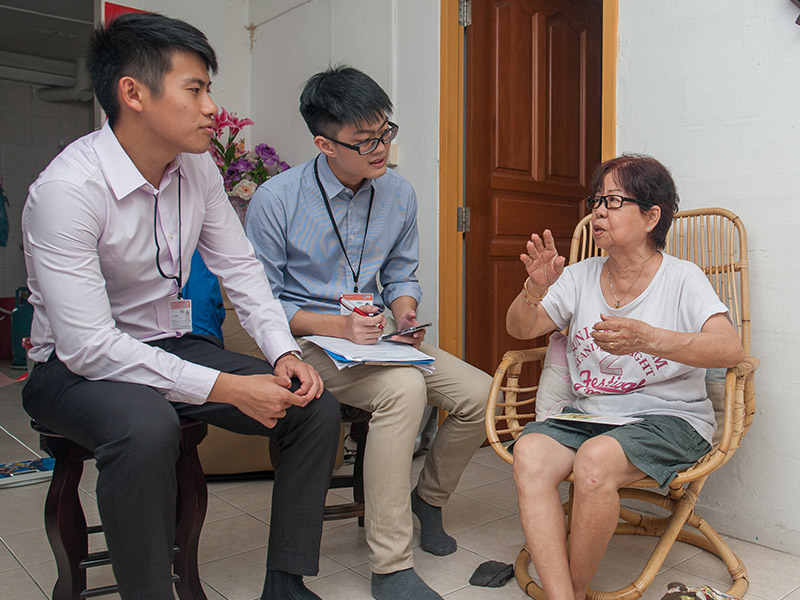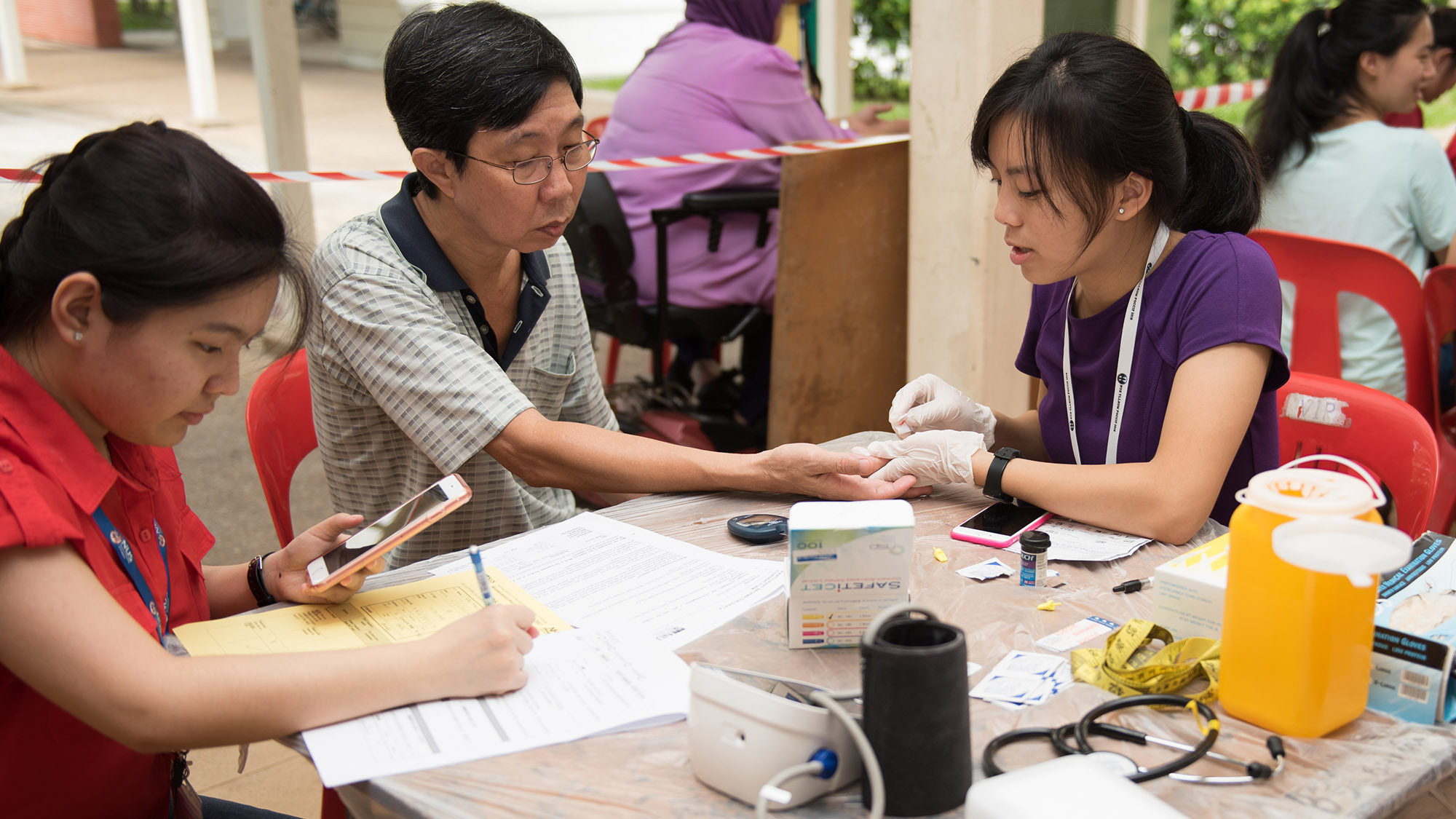At Your Service – A Decade of Neighbourly Health Screening

Medical undergraduates at the NUS Yong Loo Lin School of Medicine regularly give back to the community and one way is through the Neighbourhood Health Service (NHS). Now in its 10th year, the NHS has been providing residents of 1-2 room rental flat blocks in Singapore with free health screening and follow-up.
The NHS was started in Taman Jurong in 2007 by a group of NUS Medicine students who had experience with grassroots work and were interested in bringing health screening to the underprivileged. Taman Jurong was chosen as the first site for this project because of its strong grassroots support, large pool of needy rental-flat residents and proximity to NUS. Over the years, the numbers of residents served annually by the NHS has steadily grown from about 200 at one site in the first year to an average of ~500-600 residents per year at multiple sites today. Over successive years, the NHS has also reached out to other rental flat communities around Singapore, such as Macpherson, Bukit Merah, Marine Terrace and Eunos Crescent. While the scope and the services offered by the NHS have evolved, some elements have been maintained and handed down through successive generations of NHS student organisers.
The founding ethos of the NHS has been its focus on lower-income, rental flat residents. Since its beginning, NHS’s work has been concentrated on rental flat communities. Over the years, the NHS expanded into other geographical locations even as it kept its focus on rental flat dwellers. Why so? The main indicator of socioeconomic status in Singapore is home ownership – the majority (≥85%) of Singaporeans live in owner-occupied public housing. Through government subsidies, home ownership is high.
Public rental flats on the other hand provide heavily subsidised accommodation for the needy segment of the population. Over the years, studies by the NHS have shown that preventive healthcare services, like cancer and cardiovascular screening is less accessible to people living in rental-flat neighbourhoods, while management of chronic diseases like hypertension is also sub-optimal. Hence, the NHS targets rental flat populations in order to bridge these gaps and help the most vulnerable.
Working with rental-flat communities entails challenges. For example, as turnover is high in these neighbourhoods, some residents may not be located for follow-up. Language barriers between volunteers and residents also pose communication problems and trust-building with the grassroots is essential in order to encourage residents to open up to volunteers. However, the NHS continues to work in these communities despite these challenges because the needs are ever-present and very real.
Another characteristic of the NHS is its home-based approach. While most health screening events are held as mass events in large public spaces, the NHS reaches out to screen residents where they live, in the privacy of their own homes. Since the beginning, the NHS has held fast to this door-to-door approach. While labour intensive, going door-to-door provides greater convenience for the residents, especially the disabled who have mobility issues. In addition, bringing the conversation about screening and health into the home helps volunteers to see and identify the barriers that prevent residents in these neighbourhoods from attending screening and seeking healthcare. Holding conversations in patients’ living rooms also helps to engage family members and encourages interaction between volunteers and residents. Studies done on the NHS show that this novel home-based approach is also better in fostering empathy in these future health professionals, and helps our students to better understand the dilemmas faced by the low-income when dealing with health issues.

NHS student participants with a resident
Additionally, the NHS has always been student-run from its inception. While faculty members from the NUS Medicine and the Saw Swee Hock School of Public Health provide supervision and guidance, a student committee sits at the heart of the NHS, overseeing logistics, fundraising, publicity and succession planning, all the key functions that keep the engine of the NHS running. Key decisions – whether to expand into a new community or whether to offer new services – are decided on by the students, who retain ownership over the program. This student-run emphasis provides health professionals in-training with an opportunity to learn while at the same time, faculty support and supervision ensure that patient safety is ensured. From being run by medical students only at the outset, the NHS has broadened to include NUS Nursing and Social Work students in its programme. This reflects the increasingly inter-professional nature of the NHS and by extension, the practice and delivery of healthcare, and also serves as a good, practical setting for students to learn how to work in multi-disciplinary teams to deliver patient care.
While all these elements have remained constant, the NHS has evolved over the years. One of the changes is the renaming of the NHS to reflect its broadened focus. Initially, NHS was known as
the “Neighbourhood Health Screening”. This subsequently morphed into the “Neighbourhood Health Service” to reflect the shift in focus from only health screening to providing a more comprehensive service. At the beginning, the NHS offered blood pressure screening and BMI (body-mass-index) assessment. Over the years, this has expanded to include diabetes, cholesterol and vision screening, as well as various checks for common cancers (colorectal, breast and cervical cancers). Throughout the course of screening, it was noted that adherence to chronic disease management was also an issue in the low-income community. Thus, to improve patient care, the NHS started a follow-up service with Patient Care Conferences helmed by residents from the NUH Department of Family Medicine. The objective was not to replace the existing primary care system but to encourage these needy residents to be linked back into the system and followed up with a polyclinic doctor or general practitioner. At the same time, because many needy residents were not participating in regular screening or were not compliant with treatment because of financial and social issues, Social Work students started an initiative to link these residents to various schemes available to address these matters. Thus, the NHS has broadened over the years, moving from an initial focus on screening to what has become a holistic approach to health in the community.

Student volunteers man an NHS station
Another change was a renewed focus on measuring outcomes. The NHS has always been focused on delivering quality care and a good learning experience for its students, and measuring outcomes was a key component of tracking its ability to deliver on those goals. Over the years, the NHS has done comprehensive research on the health issues faced by residents staying in rental apartments, identifying gaps in services that could be filled. For example, in 2012 the NHS had a component centred on mental well-being, after a study found a high prevalence of depressive symptoms and cognitive impairment in the rental flat population. Medical students who had previously rotated through their psychiatry posting fanned out into the community to identify at-risk individuals, and made referrals for these persons to psychology/counselling services offered by NHS partner organisations. Being able to track and measure outcomes also helps the NHS to understand the needs of its clients and improve its services (e.g. by designing materials and programmes that appeal to the lower-income segment of the population).
Additionally, over the years, the NHS has embraced technology to improve care delivery. When the NHS first began, students went door-to-door with clipboards, pens and paper. In 2014, the NHS transitioned to a digital platform where students went door-to-door armed with iPads to key in data into a secure app-based system and
play educational videos during patient counselling. This improves efficiency and speeds up the interview process, allowing students to spend more time interacting with the residents in a meaningful way. Each year, the student organising committee also reviews its procedures and sees how the workflow can be improved to enhance the patient experience. From relying on generic materials for its health promotion efforts in the early days, the NHS has also progressed to creating its own educational materials, including pamphlets and videos. These attempt to address some of the common misperceptions about health that have been identified among residents in these low-income communities.
Hence, while preserving its ethos of community service, the NHS has also moved with the times. Key to its success, though, is the support of many individuals – from the numerous medical, nursing and social work student volunteers who participate in the programme each year, to the student committees that pass the torch on to their successors, as well as the faculty supervisors who give of their time generously in providing supervision to the students. Without the support of the grassroots organisations, partners and sponsors, the NHS would also be unable to function. And lastly, of course, we owe a debt of gratitude to the residents and patients that the NHS is dedicated to. They open their doors and their hearts to us each year – the NHS would not be possible without them.
